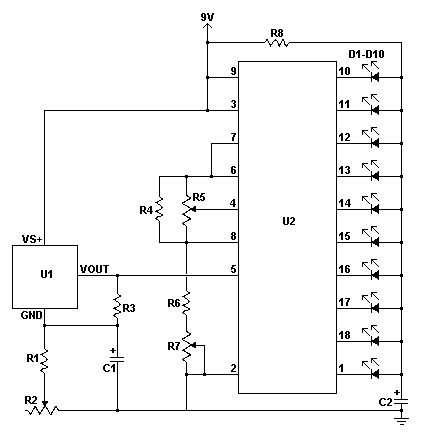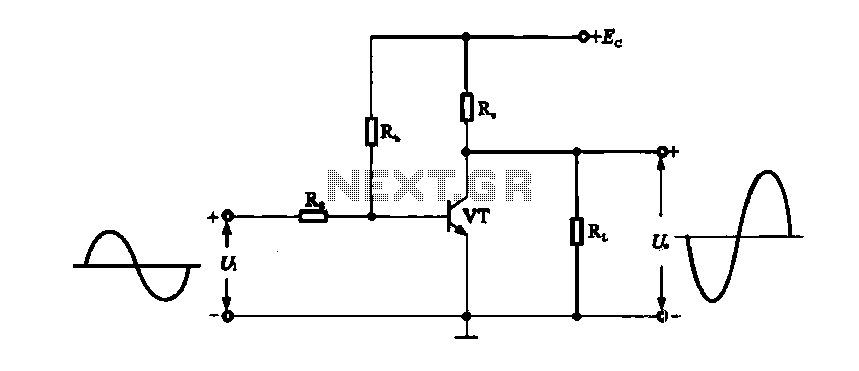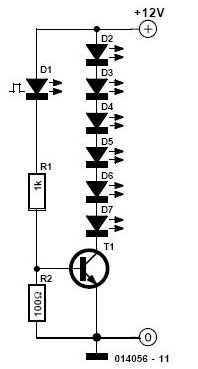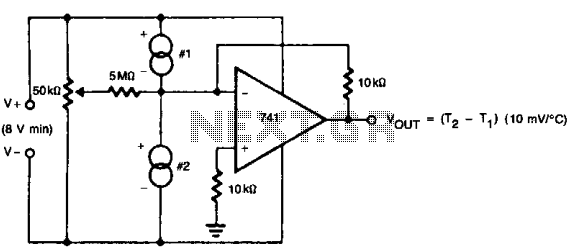
LED Thermometer

This LED thermometer is designed for home use, capable of reading temperatures between approximately 60 and 78 degrees Fahrenheit. It utilizes a precision temperature sensor IC, the LM34DZ, which requires no calibration and can measure temperatures ranging from -50°F to 300°F. While the circuit illustrated here does not utilize the full range of the sensor, it can be modified to do so by adjusting the voltage reference to U2, albeit at the expense of precision. Any LED can be used for D1 - D10; however, blue LEDs have a higher voltage requirement, which may result in them appearing dimmer compared to red, yellow, or green LEDs. If pin 9 of U2 is left disconnected, the graph will operate in dot mode, and R8 should be set to 100 Ohms. Conversely, if pin 9 is connected to 9V, the circuit will function in graph mode, requiring R8 to be set to 15 Ohms. Calibration of the circuit necessitates a voltmeter. After powering up the circuit and allowing it to stabilize for a few minutes, the negative lead of the voltmeter should be grounded, while the positive lead is connected to pins 6 and 7 of U2. R7 should be adjusted to achieve a reading as close to 3.345V as possible. Next, the positive lead of the voltmeter should be connected to pin 4 of U2, and R5 adjusted until the reading is 2.545V. Finally, power should be disconnected from the circuit, and U1 and U2 should be removed from their sockets. The resistance of R3 should be measured with an ohmmeter, and this value should be remembered. The ohmmeter should then be connected across R1, and R1 should be adjusted to exactly three times the value of R3. After reinstalling U1 and U2, the circuit will be ready for use.
The LED thermometer circuit employs the LM34DZ temperature sensor, which provides a linear voltage output proportional to temperature. The design is suitable for home applications, specifically for monitoring indoor temperatures. The choice of LED colors allows for aesthetic customization, but it is important to consider the forward voltage drop associated with different LED types. The circuit's operation mode, either dot or graph, is determined by the configuration of pin 9 on U2, which influences the visual representation of the temperature readings.
Calibration is a critical step in ensuring accurate temperature measurements. The procedure involves adjusting resistors R5 and R7 to specific voltage levels that correspond to the expected outputs of the LM34DZ sensor at known temperatures. The final adjustment of R1 ensures that the circuit maintains proper scaling, allowing for accurate readings across the intended temperature range.
The design can be further modified to extend the operating range of the LM34DZ by altering the voltage reference. However, this modification may compromise precision, necessitating careful consideration based on the application's requirements. The use of standard electronic components, such as resistors and voltage references, makes this circuit easily replicable and adaptable for various home temperature monitoring needs.This LED thermometer is designed for in home use, to read temperatures between about 60 and 78 degrees Fahrenheit. It is based around a precision temperature sensor IC, the LM34DZ. This sensor require no calibration and can measure temperatures of between -50F and 300F. While the circuit shown here does not use the full range of that sensor, it ca n be modified to do so by simply changing the voltage reference to U2 at the sacrifice of precision. You can use any LED you want for D1 - D10, however blue LEDs have a higher voltage requirement so if you want to go blue for a modern look, they may appear more dim then red, yellow or green. By leaving pin 9 of U2 disconnected, the graph will operate in dot mode and R8 should be 100 Ohm. If you build the circuit with pin 9 tied to 9V, the circuit will be in graph mode and R8 should be 15 Ohms.
To calibrate the circuit, you will need a voltmeter. Power the circuit up and let it sit for a few minutes for temperature to stabilize. Ground the negative lead of the meter and connect the positive lead to pins 6 and 7 of U2. Set R7 so the meter reads as close to 3. 345V as possible. Now connect the positive lead of the meter to pin 4 of U2 and adjust R5 until the meter reads 2. 545V. Finally, disconnect power to the circuit and remove U1 and U2 from their sockets. Measure the value of R3 with an ohmmeter and remember that value. Connect the ohmmeter across R1 and adjust R1 to a value of exactly 3 times the value of R3. Reinstall U1 and U2 and the circuit is ready for use. 🔗 External reference
The LED thermometer circuit employs the LM34DZ temperature sensor, which provides a linear voltage output proportional to temperature. The design is suitable for home applications, specifically for monitoring indoor temperatures. The choice of LED colors allows for aesthetic customization, but it is important to consider the forward voltage drop associated with different LED types. The circuit's operation mode, either dot or graph, is determined by the configuration of pin 9 on U2, which influences the visual representation of the temperature readings.
Calibration is a critical step in ensuring accurate temperature measurements. The procedure involves adjusting resistors R5 and R7 to specific voltage levels that correspond to the expected outputs of the LM34DZ sensor at known temperatures. The final adjustment of R1 ensures that the circuit maintains proper scaling, allowing for accurate readings across the intended temperature range.
The design can be further modified to extend the operating range of the LM34DZ by altering the voltage reference. However, this modification may compromise precision, necessitating careful consideration based on the application's requirements. The use of standard electronic components, such as resistors and voltage references, makes this circuit easily replicable and adaptable for various home temperature monitoring needs.This LED thermometer is designed for in home use, to read temperatures between about 60 and 78 degrees Fahrenheit. It is based around a precision temperature sensor IC, the LM34DZ. This sensor require no calibration and can measure temperatures of between -50F and 300F. While the circuit shown here does not use the full range of that sensor, it ca n be modified to do so by simply changing the voltage reference to U2 at the sacrifice of precision. You can use any LED you want for D1 - D10, however blue LEDs have a higher voltage requirement so if you want to go blue for a modern look, they may appear more dim then red, yellow or green. By leaving pin 9 of U2 disconnected, the graph will operate in dot mode and R8 should be 100 Ohm. If you build the circuit with pin 9 tied to 9V, the circuit will be in graph mode and R8 should be 15 Ohms.
To calibrate the circuit, you will need a voltmeter. Power the circuit up and let it sit for a few minutes for temperature to stabilize. Ground the negative lead of the meter and connect the positive lead to pins 6 and 7 of U2. Set R7 so the meter reads as close to 3. 345V as possible. Now connect the positive lead of the meter to pin 4 of U2 and adjust R5 until the meter reads 2. 545V. Finally, disconnect power to the circuit and remove U1 and U2 from their sockets. Measure the value of R3 with an ohmmeter and remember that value. Connect the ohmmeter across R1 and adjust R1 to a value of exactly 3 times the value of R3. Reinstall U1 and U2 and the circuit is ready for use. 🔗 External reference
Warning: include(partials/cookie-banner.php): Failed to open stream: Permission denied in /var/www/html/nextgr/view-circuit.php on line 713
Warning: include(): Failed opening 'partials/cookie-banner.php' for inclusion (include_path='.:/usr/share/php') in /var/www/html/nextgr/view-circuit.php on line 713




